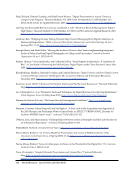190 · Representative Documents: Workflows
Yale University
Beinecke Rare Book &Manuscript Unit, Processing Manual. Electronic Files
For graphic files, Quick View Plus and other file viewers can open and display most
types of images formats. Dynamic image data (e.g., motion picture files), however, will
need to be viewed on software that can properly sequence them.
For batch files that we might describe at a finer level (e.g. Eudora e-mail folders
containing e-mail from numerous correspondents, accessible in the original Eudora
software), the access methods could take two forms: Arrange the file at the end of the
Correspondence series as a general correspondence file (e.g. “Work Letters 1997”) and
include important names in a note. Use the original software, if available, to access the
individual components, print them out, and file them as you would paper-based
correspondence. Printouts must be marked to show that they are copies of material
received in electronic form.
5.6.6 Physical Arrangement
Computer media should be placed in Restricted Fragile.
5.6.7 Description
In the finding aid, the existence, quantity, technical specifications and requirements,
and conservation relating to computer media and electronic files can be described in the
following EAD elements: Physical Description, Description of the Papers, Information
About Access, and Notes.
5.6.7.1 Physical Description extent
The extent of computer media and/or electronic files may be documented at the
collection, series/accesion, and folder level as appropriate.
When a collection or series/accession consists solely of digital records, record extent in
terms of file storage size and, in some cases, number of files. Though DACS does not
offer an example of digital extent recorded in terms of size, the general rule at 2.5.3
Yale University
Beinecke Rare Book &Manuscript Unit, Processing Manual. Electronic Files
For graphic files, Quick View Plus and other file viewers can open and display most
types of images formats. Dynamic image data (e.g., motion picture files), however, will
need to be viewed on software that can properly sequence them.
For batch files that we might describe at a finer level (e.g. Eudora e-mail folders
containing e-mail from numerous correspondents, accessible in the original Eudora
software), the access methods could take two forms: Arrange the file at the end of the
Correspondence series as a general correspondence file (e.g. “Work Letters 1997”) and
include important names in a note. Use the original software, if available, to access the
individual components, print them out, and file them as you would paper-based
correspondence. Printouts must be marked to show that they are copies of material
received in electronic form.
5.6.6 Physical Arrangement
Computer media should be placed in Restricted Fragile.
5.6.7 Description
In the finding aid, the existence, quantity, technical specifications and requirements,
and conservation relating to computer media and electronic files can be described in the
following EAD elements: Physical Description, Description of the Papers, Information
About Access, and Notes.
5.6.7.1 Physical Description extent
The extent of computer media and/or electronic files may be documented at the
collection, series/accesion, and folder level as appropriate.
When a collection or series/accession consists solely of digital records, record extent in
terms of file storage size and, in some cases, number of files. Though DACS does not
offer an example of digital extent recorded in terms of size, the general rule at 2.5.3










































































































































































































